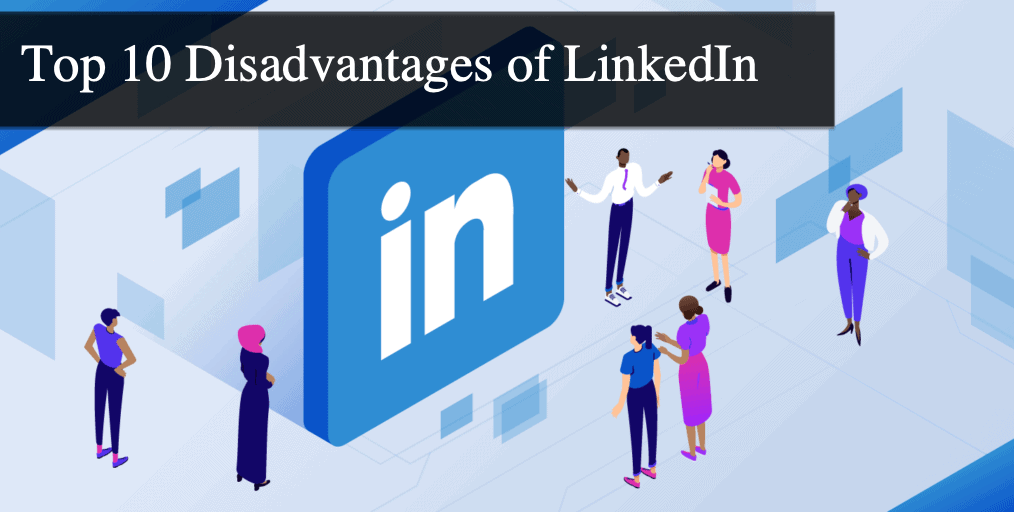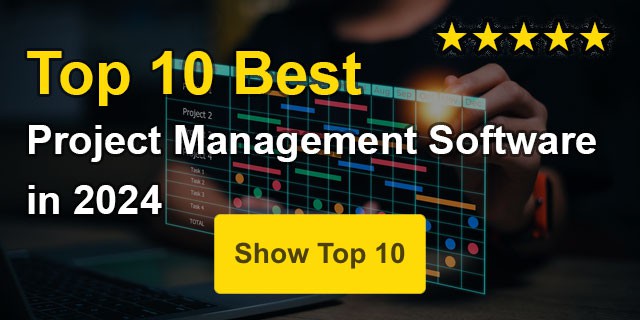Top 10 Cons & Disadvantages of LinkedIn

In professional networking, LinkedIn stands as a dominant platform. However, even the most ubiquitous tools have their downsides. This article aims to explore the less-discussed aspects of LinkedIn, mainly focusing on its potential disadvantages. As a seasoned project manager with two decades of experience, I’ve witnessed the evolution of LinkedIn and how its features impact professionals across various industries.
At its core, LinkedIn is designed to connect professionals, offering a space for networking, job hunting, and career development. But beneath this surface, some nuances often go unnoticed or unaddressed. These can have significant implications, especially for those who rely heavily on the platform for professional advancement. In my journey, I’ve observed how certain aspects of LinkedIn can be counterproductive, even for the most experienced professionals. This article aims to shed light on these less favorable elements, providing a comprehensive overview of the potential pitfalls of relying on LinkedIn.
10 Cons & Disadvantages of Using LinkedIn
Identifying LinkedIn’s top ten cons and disadvantages requires a deep dive into the platform’s mechanics and its impact on the user base. From issues of privacy and data security to the sometimes overwhelming nature of networking on such a vast platform, these disadvantages are multifaceted. The platform’s algorithmic biases, the pressure to maintain a specific professional image, and the potential for misinformation are also critical concerns. These factors contribute to a broader understanding of LinkedIn’s limitations as a professional networking tool.
1. Privacy Concerns
Privacy on LinkedIn is a multifaceted issue. As a social network that houses professional information, the stakes for privacy breaches are high. Users often share detailed career histories, personal achievements, and sometimes even personal contact information, making privacy a paramount concern.
- Data Collection: LinkedIn collects a vast amount of personal and professional data.
- Third-party Access: User information is often accessible to third-party applications and advertisers.
- Profile Visibility: Even with privacy settings, certain information remains visible to all users.
Real-life Example: John, a project manager, discovered his entire work history and educational background were accessible to a potential employer who wasn’t connected to him on LinkedIn. This led to unsolicited job offers and privacy concerns.
Solution: Enhancing privacy settings, regular audits of connected applications, and being selective about shared information can mitigate these concerns. LinkedIn could also improve user control over data visibility and sharing.
2. Overemphasis on Quantifiable Achievements
LinkedIn’s structure inherently promotes an overemphasis on quantifiable achievements. The platform encourages showcasing awards, endorsements, and a linear career trajectory, which can overshadow other valuable professional qualities.
- Skill Endorsements: Sometimes, these are given by connections who have no real insight into the user’s abilities.
- Achievement Focus: Overemphasis on titles and awards can detract from the importance of soft skills and experience.
- Comparison Culture: Creates a competitive environment where users feel pressure to inflate their accomplishments.
Real-life Example: Sarah, a marketing specialist, felt compelled to embellish her achievements to keep up with her peers on LinkedIn, leading to unrealistic job expectations from employers.
Solution: Promoting a balanced representation of skills, focusing on genuine endorsements, and providing avenues to showcase soft skills and personal growth stories could offer a more holistic view of a professional’s capabilities.
3. Algorithmic Bias
The algorithm that powers LinkedIn’s feed and job recommendations is not without its biases. These can affect the visibility of profiles and job postings, often favoring certain content over others.
- Content Visibility: Popular content is more likely to be shown, overshadowing valuable but less ‘engaging’ content.
- Job Recommendations: Biases in job recommendations can limit opportunities for some users.
- Networking Biases: The algorithm may favor connections within specific industries or levels, hindering diverse networking.
Real-life Example: Emma, an IT professional, noticed that her technical articles received less visibility than generic motivational posts, impacting her ability to network effectively.
Solution: A more transparent and equitable algorithm that gives equal visibility to diverse content and job opportunities can enhance the platform’s inclusivity and effectiveness.
4. Overreliance on Connections
LinkedIn’s emphasis on connections can lead to an overreliance on who you know rather than what you know. This can create barriers for individuals who may not have extensive networks.
- Networking Pressure: There’s an implicit pressure to expand one’s network constantly.
- Quality vs. Quantity: The focus often shifts from meaningful connections to increasing numbers.
- Access to Opportunities: Those with fewer connections might miss out on job opportunities or essential updates.
Real-life Example: Michael, a recent graduate, found it challenging to gain traction on LinkedIn due to his limited professional network, hindering his job search efforts.
Solution: Encouraging meaningful connections over quantity, providing more opportunities for new users to connect with experienced professionals, and ensuring job opportunities are not solely reliant on connections can create a more level playing field.
5. Pressure to Maintain a Professional Image
Maintaining a constantly polished and professional image on LinkedIn can be daunting. This can lead to a lack of authenticity and a one-dimensional portrayal of professionals.
- Professional Persona: Users often feel compelled to present an idealized version of their professional selves.
- Authenticity Gap: This pressure can disconnect a person’s online persona and real-life skills and experiences.
- Stress and Anxiety: Constantly curating a professional image can be stressful and impact mental well-being.
Real-life Example: Linda, a seasoned project manager, felt the pressure to continuously update her profile with new achievements, leading to anxiety and a sense of inadequacy.
Solution: Fostering a culture that values authenticity and holistic professional development can alleviate this pressure. LinkedIn could also highlight diverse professional journeys, including challenges and failures, to promote a more realistic professional landscape.
6. Misinformation and Overhyped Content
LinkedIn is not immune to the spread of misinformation and overhyped content. The drive for engagement can sometimes overshadow the need for accuracy and meaningful discourse.
- Viral Content: Trending posts may not always be factually accurate or professionally relevant.
- Misleading Information: Users can encounter misleading career advice or business strategies.
- Pressure to Engage: The focus on engagement can lead users to interact with or share content without proper verification.
Real-life Example: Alex, an entrepreneur, followed business advice from a viral LinkedIn post, leading to a misguided strategy and financial loss.
Solution: Mitigating the spread of misinformation can be mitigated by implementing more robust fact-checking measures, promoting content from verified sources, and educating users about critical evaluation of online content.
7. Limited Functionality for Certain Professions
LinkedIn’s design and functionality are not equally beneficial for all professions. Creative and non-traditional roles often find the platform’s structure limiting in showcasing their skills and experiences.
- Portfolio Display: Limited options for displaying creative work or non-linear career paths.
- Industry Bias: The platform is more conducive to traditional corporate professions.
- Networking Challenges: Professionals in niche fields may find it harder to connect with relevant peers.
Real-life Example: Emily, a freelance graphic designer, struggled to effectively showcase her portfolio and find relevant connections within her industry on LinkedIn.
Solution: Enhancing the platform’s features to accommodate diverse professional needs, including better portfolio integration and industry-specific networking tools, can make LinkedIn more inclusive.
8. Ineffective Job Matching
While LinkedIn aims to connect job seekers with potential employers, the effectiveness of its job-matching algorithms is sometimes questionable. This can lead to irrelevant job suggestions and missed opportunities.
- Algorithm Limitations: The job matching system may not accurately interpret user skills and preferences.
- Irrelevant Suggestions: Users often receive job recommendations that don’t align with their expertise or interests.
- Opportunity Misses: Due to algorithmic shortcomings, suitable job listings might not reach the right candidates.
Real-life Example: Raj, a software engineer, consistently received job suggestions for roles unrelated to his expertise, leading to frustration and a prolonged job search.
Solution: Improving the job matching algorithm to better understand user profiles and preferences and allowing more customized job search criteria can enhance the platform’s effectiveness in connecting job seekers with suitable opportunities.
9. Overwhelming Nature of Networking
The vastness of LinkedIn’s network can sometimes be overwhelming. The sheer number of users, posts, and notifications can make navigating and effectively using the platform challenging.
- Information Overload: Users can be bombarded with too much information and updates.
- Networking Fatigue: Constant interaction and networking demands can lead to burnout.
- Difficulty in Finding Value: Sifting through the volume to find valuable connections and content can be daunting.
Real-life Example: Carlos, a business consultant, was overwhelmed by the constant influx of requests, updates, and information, making it difficult to focus on meaningful engagements.
Solution: Introducing features that help manage and filter content and tools to streamline networking efforts can make the platform more user-friendly and less overwhelming.
10. Platform Monopolization
LinkedIn’s dominance in professional networking can lead to a monopolization effect. This lack of competition can stifle innovation and limit user choices.
- Limited Alternatives: Few platforms offer the same professional networking and visibility level.
- Innovation Stagnation: Dominance in the market can lead to complacency and slower introduction of new features.
- User Dependency: Heavy reliance on LinkedIn for professional purposes can limit exploration of other platforms or networking methods.
Real-life Example: Sophia, a human resources professional, was overly reliant on LinkedIn for recruitment, missing out on potential candidates from other platforms.
Solution: Encouraging the development of alternative platforms and integrating them with other professional tools can foster a healthier competitive environment and provide users with more choices.
How Could these Disadvantages be Overcome Globally?
To address the disadvantages identified in LinkedIn, several strategic improvements can be implemented. These changes should focus on enhancing user experience, privacy, and the overall effectiveness of the platform.
- Improved Privacy Controls: Enhance user control over their data and visibility on the platform.
- Develop advanced privacy settings to allow users to fine-tune who can view their information.
- Implement regular privacy audits to ensure user data is protected.
- Balanced Content Representation: Encourage a diversity of content beyond quantifiable achievements.
- Promote features that allow users to showcase soft skills and holistic career journeys.
- Implement algorithms that equally value different types of professional accomplishments.
- Algorithm Transparency and Equity: Make the platform’s algorithms more transparent and less biased.
- Redesign algorithms to reduce inherent biases and promote diverse networking opportunities.
- Offer users insights into how their data is used in these algorithms.
- Enhanced Job Matching System: Improve the accuracy and relevance of job recommendations.
- Utilize more sophisticated AI to understand and match user skills and job preferences.
- Allow for more detailed and customized job search parameters.
- Platform Diversification and Innovation: Encourage innovation and development of alternative networking tools.
- Foster partnerships with other platforms to provide a more rounded networking experience.
- Continuously update and introduce new features to stay ahead of evolving professional needs.
Top 5 Best LinkedIn Marketing Agencies
LinkedIn is the premier platform for B2B marketing, offering unique opportunities for networking, branding, and lead generation. Selecting an expert LinkedIn marketing agency can dramatically improve your company’s visibility and influence within your industry. These agencies specialize in optimizing LinkedIn strategies to connect with professionals and decision-makers. Here are the top five agencies known for their exceptional ability to harness LinkedIn’s potential to foster business relationships and drive growth.
- Bop Design: Bop Design excels at creating bespoke LinkedIn marketing strategies that enhance brand presence and generate leads among industry professionals. Their focus on B2B markets ensures tailored content that resonates with the target audience.
- Lead Cookie: Renowned for their lead generation expertise, Lead Cookie helps businesses maximize their LinkedIn presence to generate and nurture leads. They provide hands-on support in optimizing profiles and developing engagement strategies that produce tangible business opportunities.
- LinkedSelling: LinkedSelling is a leader in strategic LinkedIn lead generation, utilizing organic engagement and targeted outreach to build relationships and drive sales. Their comprehensive approach includes content marketing, lead management, and detailed analytics to track campaign success.
- Sculpt: Sculpt combines creative storytelling with strategic insights to elevate companies’ LinkedIn marketing. They focus on creating compelling content and leveraging LinkedIn’s networking tools to increase brand authority and foster valuable professional connections.
- Top Dog Social Media: Top Dog Social Media specializes in helping businesses harness the power of LinkedIn for professional networking and growth. They offer a comprehensive suite of services, including profile optimization, strategic content creation, and personalized coaching to enhance engagement and build meaningful professional relationships.
What is LinkedIn? The Definition.
LinkedIn is a social networking platform specifically designed for professional networking and career development. Launched in 2003, it has since become the go-to platform for professionals seeking to connect, share insights, and discover new job opportunities. Unlike other social media platforms, LinkedIn focuses on professional experiences, skills, and achievements. It serves as a digital resume, a networking space, and a job market, all rolled into one. Users range from individuals looking to advance their careers to companies seeking talent and professionals wanting to share industry insights. The platform’s unique position in the digital space has made it an indispensable tool for modern professionals.
- Professional Networking: Connects professionals across various industries globally.
- Job Market: Hosts a vast array of job listings and recruitment tools.
- Skill Development: Offers learning resources and insights into industry trends.
- Content Sharing: Enables sharing of professional insights, articles, and achievements.
- Digital Resume: Acts as a public, interactive resume for individuals.
Real-life Example: Jane, a digital marketing expert, used LinkedIn to transition from a local firm to a multinational company. By showcasing her portfolio, engaging with industry content, and connecting with key professionals in her field, she gained visibility and eventually landed her dream job.
Researches about LinkedIn
Studies on LinkedIn have focused on various aspects such as its impact on recruitment, networking strategies, and user behavior analysis. These research efforts provide valuable insights into how the platform is used and its effects on professional life. They examine LinkedIn’s role in shaping modern job markets, its influence on professional identities, and how it affects job searching and hiring processes. Research has also delved into the data privacy concerns and the algorithmic biases present in the platform. Such studies are crucial in understanding the broader implications of LinkedIn in both the professional and personal realms of its users.
- 10 Big LinkedIn Trends That Will Impact Hiring And Recruiting This Year
- How to Network on LinkedIn – 10 Do’s and Don’ts for You to Consider
- LinkedIn Analytics: The 2024 Guide for Marketers
- The Importance of a LinkedIn Profile for Your Career
- LinkedIn Data Leak – What We Can Do About It
Videos about LinkedIn
A variety of videos can be found that delve into different aspects of LinkedIn. These include tutorials on optimizing profiles, strategies for effective networking, and advice on using LinkedIn for job searching. There are also discussions and analyses of LinkedIn’s role in the professional world, interviews with successful users who leveraged the platform for career growth, and critiques of LinkedIn’s policies and features. These videos range from professional webinars and educational courses to informal vlogs and user testimonials, offering a broad spectrum of perspectives and insights.
Conclusion
In conclusion, while LinkedIn stands as a pivotal tool in the professional landscape, its various disadvantages highlight the need for continual evolution and user-centric improvements. Addressing issues related to privacy, content diversity, algorithmic bias, job matching, and platform monopolization can significantly enhance the user experience. It’s imperative for LinkedIn to adapt and respond to these challenges to maintain its relevance and utility for professionals across diverse fields.
Furthermore, as the digital landscape transforms, LinkedIn’s role as a hub for professional networking and career development becomes increasingly crucial. By navigating its shortcomings and leveraging its strengths, users can optimize their LinkedIn experience. Meanwhile, ongoing research and user feedback will continue to shape the platform’s future, ensuring it remains an invaluable asset for the global professional community.



